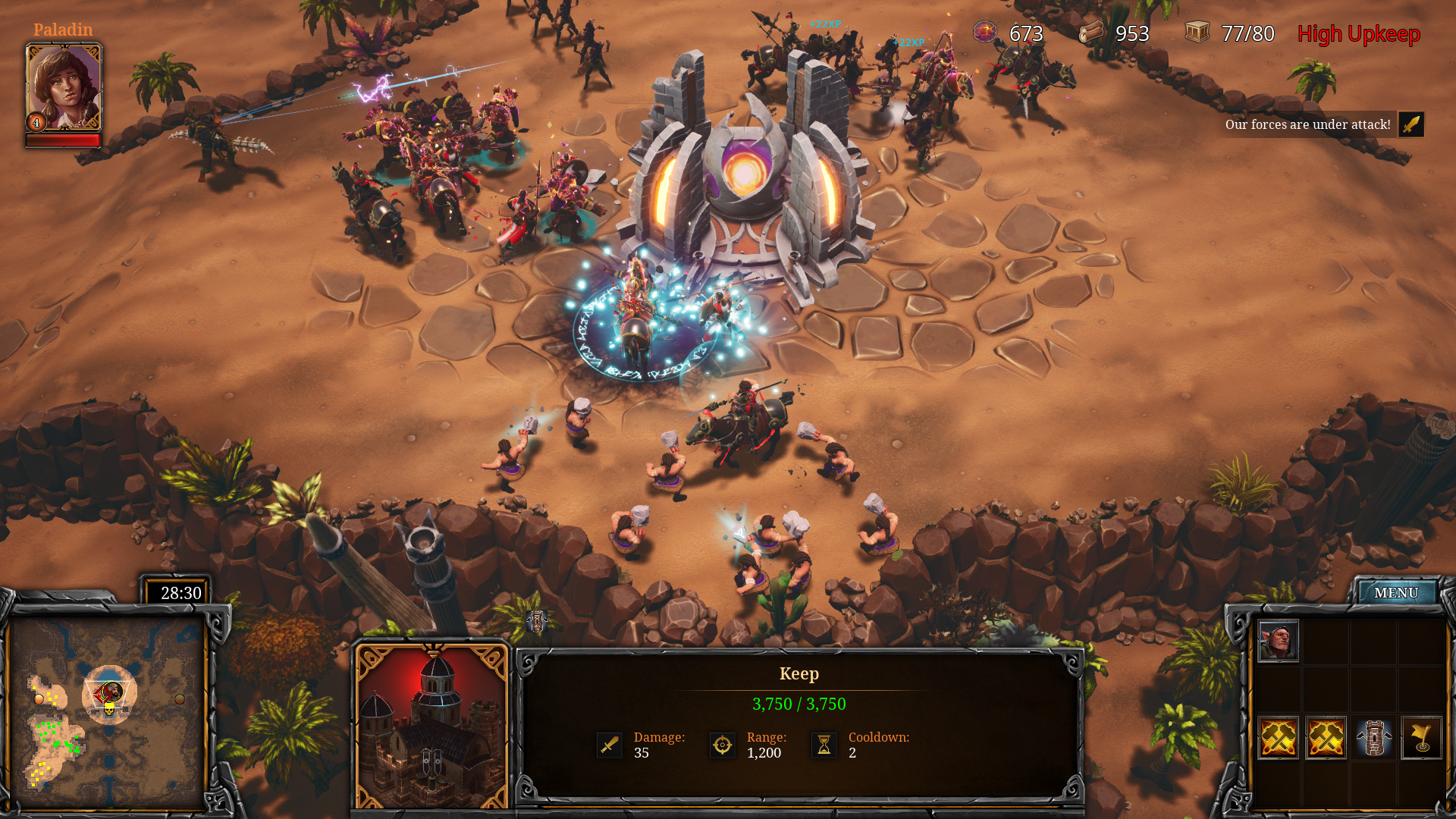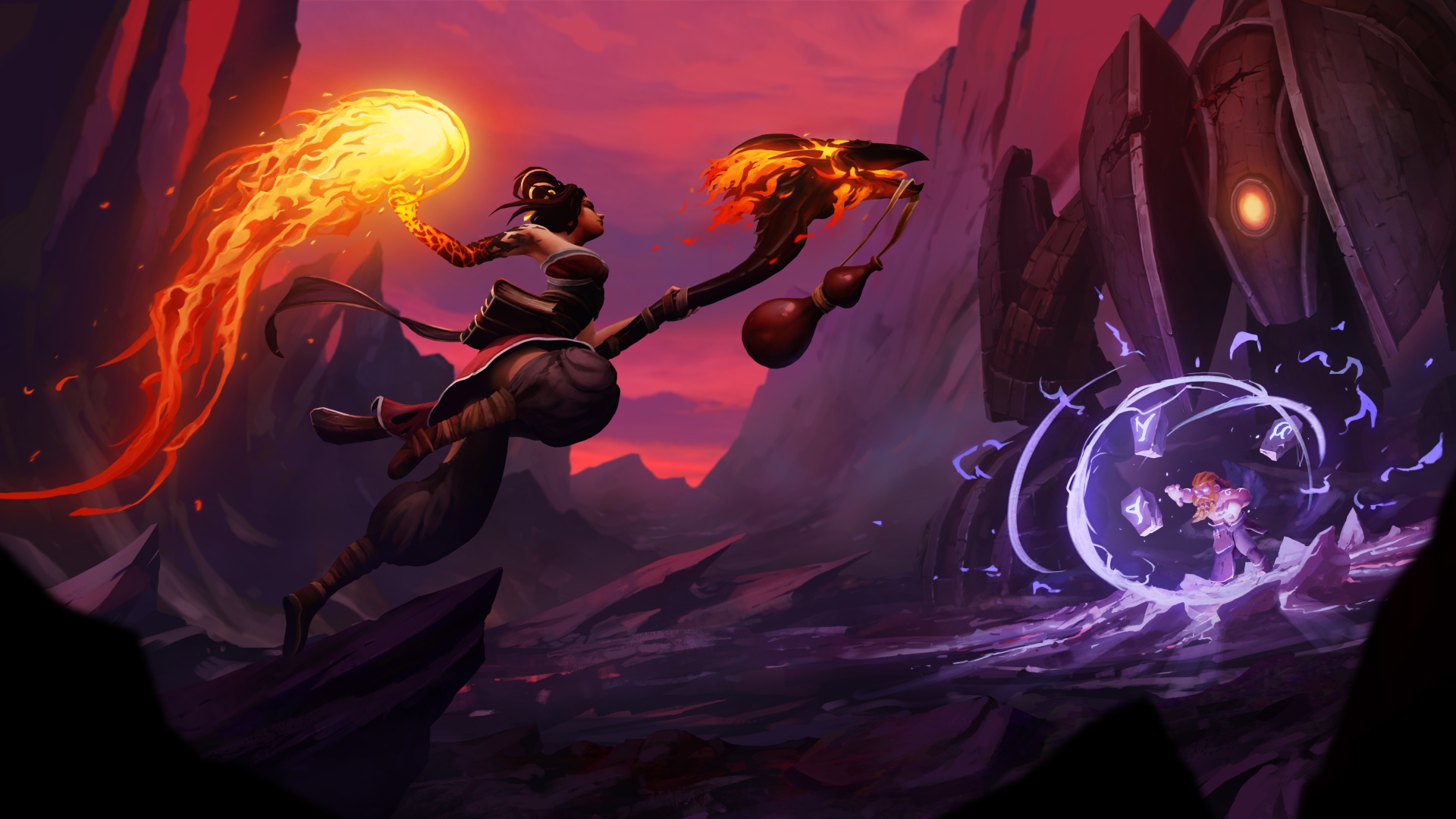A Year Of Rain is an accessible if ambitious upcoming co-op RTS
War makes monsters of us all
I was nervous, sitting down to play A Year Of Rain. I don’t have a lot of experience with real-time strategy games, and even though technical director Nick Prühs had explained some of the accessibility features, it still looked intimidating. Plus, as a co-op and a competitive game, it has twice the number of people available to embarrass myself in front of.
As I dug in, turtling in a corner where I assumed no one would notice me, three opposing horsemen showed up to attack one of my buildings. I sent some people to gently chase them off, but a developer watching over my shoulder suggested that I pursue them. Within minutes, my army of spearmen and clerics were a wave that crashed into their buildings and overwhelmed their units. Suffice to say I didn’t feel nervous after that. There may, in fact, have been gleeful giggling involved.
A Year Of Rain is a fantasy RTS. Fans of the genre won't find formerly story-focused developers Daedalic Entertainment trying to reinvent the wheel, but they are throwing a few twists into the mix. The most obvious of these is that the game is entirely cooperative. Three game modes – a 2v2 clash, a story-focused campaign, and a pair-versus-an-army struggle called Against All Odds – all require you to play with a buddy. If you don’t have one available and don't fancy matchmaking, the game can provide an AI helper, but there’s no way to play entirely alone.
Admittedly, this didn't totally come across in my game. Though there were four players, I never communicated with my ally (in fact, I never figured out which of the other journalists in the room it was). I also only saw one opponent, and the game ended for all of us when I ran over them.
It's understandable that four new players just trying to get to grips with the game would not be a perfect simulation, though. And as Prühs tells it, there are some aspects that are impossible without direct cooperation. Boss fights, for example, need both people, and can be further complicated by the opposing team, who could use this advantage to launch a sneak attack, or even kill-steal the final hit on the boss, so it’ll always need to be a calculated offense. Beating a boss (at least in the current iteration, the game is still changing rapidly) grants a temporary buff to your army, pushing your team to move onto attacking your opponents quickly even if you’ve suffered losses, because the developers want to enforce quick, decisive games rather than "slow death."
Players can currently use an in-game text chat, but Prühs says they're working on a ping system to further facilitate this kind of cooperation. Mentoring will also be encouraged, since playing with someone of a different skill level will give bonus XP at the end of the game, allowing for quicker levelling towards hero portraits and the like. (How effective it’ll be at encouraging friendliness is, obviously, another question.)
Prühs also says that the game doesn't stray too far from the studio's narrative roots. "We definitely still want to tell stories," he tells me. To do so, they've created a slate of hero characters who will be central to the campaign mode.
I don’t get to see any of the story, but what I get from the setting feels a little different from the generic European medieval fantasy. The banner they roll out features an Asian woman, perched mid-air with one arm burning up and the other cradling a flaming staff. Opening the game reveals a light-skinned black woman reaching towards the camera on the menu screen. She’s a paladin, and I choose her as my hero, the lynchpin of my army who both deals significant damage and has her own powerful abilities like keeping my units healed up. When we kill the opposing hero, they’re only out of the fight for a short while, but it’s the perfect time to press the attack.
Prühs tells me that the paladin’s name is Killian, and that in the campaign, a pair will experience the narrative together, through situational dialogue between heroes and cutscenes, some of which may also vary between players depending on their position on the battlefield.
“From the very first moment we definitely wanted to just back off a little bit from what we like to call the 'captain obvious' fantasy,” he says, and explains that having a varied cast of heroes is in part a practicality. “Even if we didn’t want to – which we do! – but we would be forced to do it because the characters have to be pretty easily distinguishable…players have to be immediately aware of which characters are running around.”
This is also something of a departure for Daedalic, though. Their previous flagship series, Deponia, led John to a series of reviews that become increasingly exasperated with both the puzzles and the sexism, racism, and transphobia found within.
Without playing any of the campaign, it's very difficult to say how effective this turnaround might be. On one hand, the last Deponia game came out three years ago, and speaking to Prühs feels genuine. He tells me that they wanted a female main character from “the first week or so,” and that Killian is currently being redesigned to wear slightly heavier armour, though she was never one of the “uncovered belly women who are almost naked yet still frontline [fighters].”
On the other hand, even with the best intentions getting inclusivity right can be difficult. And little things, like the three posters I see for 2013's Goodbye Deponia, which prominently feature the female protagonist falling towards the camera wearing only her underwear, make me wonder to what extent the studio is dedicated to turning this new leaf.
Still, if this cast does succeed in bringing new players to the genre, à la Overwatch or Apex Legends, they'll find something accessible. A suggested progression checklist will ease the unfamiliar into understanding what might be best to build when you reach certain resource thresholds, for example. It's simple, but goes a long way to flattening the often intimidating strategy-game learning curve. Prühs also explains that they've pared down any “annoying” elements, like Starcraft's infamous demand for additional pylons.
How this simplification might impact Daedalic’s nebulous esports ambitions for the game is unclear, and Prühs can’t tell me exactly how they’ll fund ongoing support for the game, either. “We are still contemplating different models and I can’t say much more because actually I don’t know much more,” he says, though he details some of the options they are considering once the game launches into early access this year. They include selling additional story campaigns; cosmetics like titles, portraits, and hero skins; and extra maps. They’re cautious, though, especially with the latter. “If people are already into early access then it doesn’t feel right to charge them additional money because the early access label already says additional things will come in the future, then charging them again for these new things feels kind of bad," he muses.
That's a lot of unknowns that need solving if A Year Of Rain has any hope of becoming the hottest new games-as-service co-operative multiplayer esport bonanza. And yet, being taught how to build my small-village-worth of clerics was straightforward without being patronising, and then turning on that poor scouting party of three horses and letting momentum do the rest was intensely satisfying. I find myself hopeful that Daedalic can make something of this, both in terms of wanting it to become a good version of the foundations they've already laid, and thinking it could be possible.




